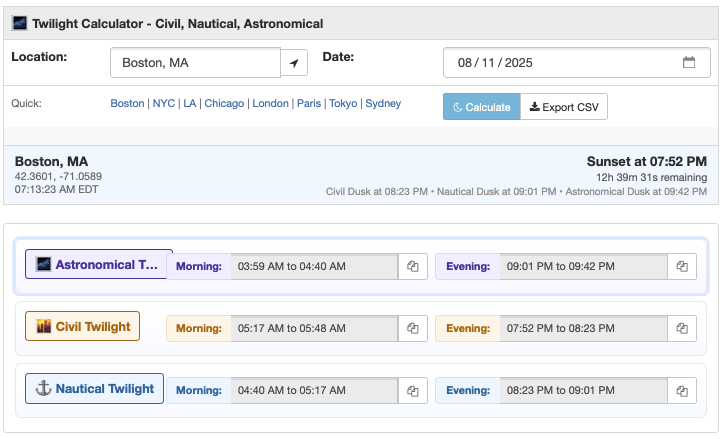Need to know when the sky is dark enough to see the Andromeda Galaxy with your eyes? Our astronomical twilight calculator shows you when true darkness arrives and the sun's glow finally stops interfering with your view of the cosmos.
Features of the astronomical twilight calculator
For those chasing photons from distant galaxies, here's a dark sky toolkit:
- Morning and evening darkness: Astronomical dawn ends darkness, astronomical dusk begins it
- Duration display: See how long you have for true dark-sky observation
- Location search: Find dark sky sites, observatories, or your backyard coordinates. You can also use the GPS button to match your device location... or directly enter latitude and longitude
- Copy buttons: Quickly transfer twilight times to observation logs or imaging plans
- CSV export: Download this math for astronomy planning spreadsheets
- Live countdown: Real-time darkness tracking
We use SunCalc.js for calculations, and cities.json for location lookup.
Compare twilight types
Astronomical twilight is the darkest of the three twilight phases:
- Civil Twilight Calculator (−6° to 0°): General outdoor visibility
- Nautical Twilight Calculator (−12° to −6°): Horizon visible for navigation
- Astronomical Twilight (−18° to −12°): Current tool – when it is generally dark enough for astronomy
- All Twilight Types: Compare all three twilights on one page
All twilight types show on this page, but astronomical twilight gets star billing (pun, as you might have guessed, intended).

What is astronomical twilight?
Astronomical twilight occurs when the sun's center is between 12° and 18° below the horizon. Beyond 18°, you've reached astronomical darkness – the sun no longer illuminates the atmosphere above you. It happens twice daily: astronomical dawn (darkness ending) and astronomical dusk (darkness beginning).
When the sun finally drops past that 18° mark, we're in pure night – at least, as pure as it gets with modern light pollution. (Ahem).
Understanding astronomical twilight duration
Like all twilights, duration depends on your latitude and the season:
- Equator: ~25-28 minutes year-round
- Mid-latitudes (40°): 35-45 minutes, longer in summer
- High latitudes (60°): 60-180+ minutes, or never-ending in summer
- Above 48.5° latitude in summer: No astronomical darkness ("grey nights")
That last point is cruel for northern astronomers – when the weather's nice, true darkness vanishes for weeks. In London (51.5°N), astronomical darkness disappears from late May to mid-July.
Want to see where darkness currently reigns? Our day/night world map shows all twilight zones live.
Related tools
- Moon Phase Calculator - Check if moonlight will interfere
- Sunrise Sunset Calculator - Full day/night cycle planning
- Solar Tracker Map - Live view of Earth's dark side
- Day Night World Map - See global darkness patterns
- Days Calculator - Count days to new moon
- World Clock - Coordinate with observatories globally
- Civil Twilight Calculator - When outdoor visibility ends
- Nautical Twilight Calculator - When the horizon disappears
- Day of Year Calculator - Track Julian dates for observations
- Hours Between Times - Calculate total darkness duration
When you're wondering when you can finally see the Milky Way, astronomical twilight marks the boundary between skyglow and true night. And yes, this is an astronomically useful tool. Thanks for observing.
